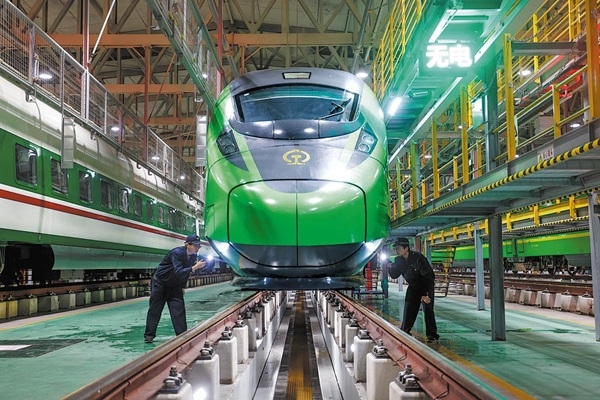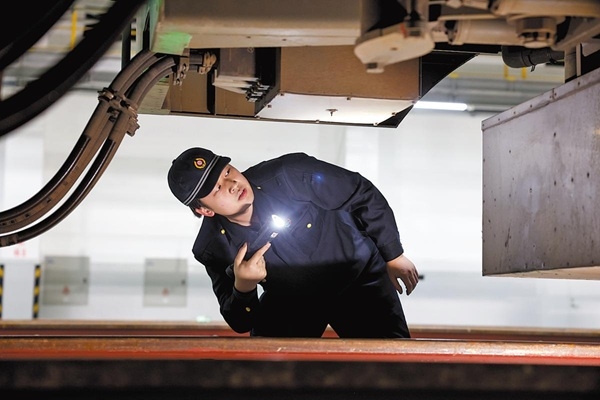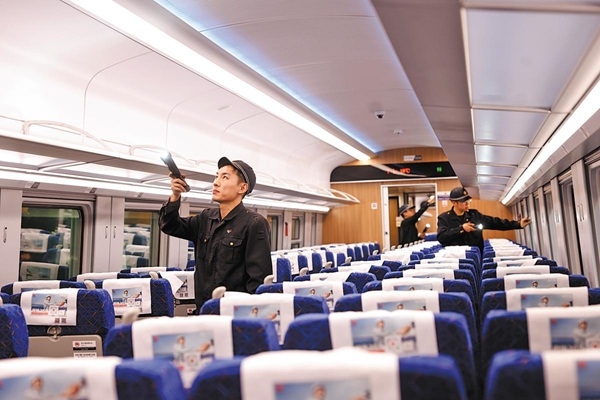Technicians keep trains running smoothly during travel rush
Technicians inspect the undercarriage of a train at a maintenance base in Jinan, Shandong province. [Photo provided to CHINA DAILY]
While many Chinese people prepare themselves for the Spring Festival break, teams of maintenance workers across the country are hard at work ensuring the nation's vast train network runs without a hitch over the busy travel period.
Each evening during the travel rush, which officially began on Jan 14, the six tracks at a train maintenance base operated by China Railway Jinan Group Co host a lineup of high-speed trains awaiting thorough examinations after a day's service. The maintenance base in Jinan, Shandong province, is brightly lit, with technicians bustling around to prepare the trains for their upcoming journeys.
"During the Spring Festival travel rush our workload has surged by 25 percent," said Tian Yu, a technician at the maintenance base.
At around 6 pm, a train rolls into the base, signaling the start of the night shift for the technicians.
"Each train undergoes a three-hour inspection by a team of six ground maintenance technicians," said Tian.
"We check critical components such as anti-skid systems, basic braking devices and electrical installations, ensuring that no potential issues go unnoticed," he said.
The technicians' tasks are coordinated through a central control system at the dispatch center, equipped with 12 high-definition screens for real-time monitoring to streamline operations.
Before moving to the maintenance tracks, the trains undergo an initial check by an intelligent fault diagnosis system.
Any issues identified by the intelligent equipment are manually rechecked by maintenance technicians, who then conduct detailed and thorough inspections of the train components to uphold maintenance quality.
A technician checks the underside of a train at the maintenance base. [Photo provided to CHINA DAILY]
Checks underneath
Within the maintenance site, technicians need to venture into a nearly one-meter-deep inspection passageway, where bright lights illuminate the undercarriage of the train.
"Inspecting components demands side lighting from various angles. Even tiny cracks as fine as a strand of hair, when illuminated by a flashlight, can reveal minor fractures and beam cross-sections that necessitate careful observation and assessment," said Wu Yingqiang, the Party secretary of the maintenance base.
"When it comes to safety, there are no shortcuts, and any hint of negligence is unacceptable," said Wu.
Under auxiliary work platforms situated on each side of inspection passageways, heating devices are installed, easily distinguishable due to the temperature contrast with the ground.
This arrangement plays a critical role in maintaining the trains, particularly during the winter season when they traverse snow-prone cities like Yantai and Weihai in the eastern region of Shandong province.
In these areas, snow can accumulate beneath the trains due to strong air currents, gradually turning into ice as temperatures fall.
This ice can adhere to components such as brake equipment beneath the train. Prior to the routine inspection, a de-icing procedure is essential to thaw the snow and ice buildup, enabling a thorough underside examination.
"In the past, de-icing was a labor-intensive process that involved manual labor using small hammers. It required a delicate touch — too gentle was ineffective, while excessive force posed a risk of damaging the components," said technician Tian.
A team of four people used to spend nearly two hours to complete the de-icing work for a train with eight carriages, he said.
But now, with the introduction of heating devices, the ice melts into water within a mere 20 minutes, streamlining the process and reducing the labor intensity significantly.
Technicians inspect the interior of a train carriage at a maintenance base in Jinan, Shandong province. [Photo provided to CHINA DAILY]
Interior inspection
Inspecting the interiors of train carriages also poses challenges for technicians.
"I need to examine and test numerous components, including those in the restroom, across a minimum of eight carriages," said 24-year-old technician Cheng Yawen.
During the Spring Festival travel rush, the frequent use of electronic devices by passengers can lead to charging sockets loosening. In one carriage that equips all its 56 seats with a charging socket, Cheng uses testing equipment to evaluate each socket's functionality and power supply.
"While assessing the sockets, we also inspect the stability of the seats, the pedals and the window sealing strips," said Cheng.
Due to the nature of overnight operations, physical demands and the diverse range of tasks required, maintenance technicians are predominantly male, with only 9.5 percent of the workforce being female. Cheng, one of the few females in her team, upholds stringent standards in her work.
During an inspection of the restroom, Cheng noticed that the toilet's flush area extended beyond the basin. Taking immediate action, she knelt down and adjusted the angle of the nozzle until the issue was rectified.
"Being a train technician is in no way easy, and I have to overcome numerous challenges to make myself qualified for this job," she said.
To become a maintenance technician, each worker must first acquire a full qualification through a combination of theoretical knowledge and practical assessments. They then need to meet the specified on-duty standards for a particular operation before being authorized to carry it out.
Currently, the team in Jinan has established "on-duty standards" for 37 crucial operations across five maintenance-related categories, encompassing tasks such as de-icing and brake checks.
Regular reviews of qualifications are conducted to ensure that technicians possess the requisite knowledge and skills.
"If a technician has not performed a specific operation within a year, their qualification will be revoked," Party secretary Wu said, underscoring the importance of ongoing proficiency and engagement in the maintenance tasks.
In order to ensure a safe and comfortable travel experience for passengers, a technician accompanies the train while it's in service, conducting inspections every three hours across its eight carriages.
They focus on facilities such as distribution cabinets, faucets and carriage doors, addressing any anomalies promptly. They also adjust carriage temperatures based on passengers' needs.
"To accommodate the high volume of luggage during the Spring Festival travel rush, we ensure that the luggage racks are secure and stable to meet passengers' storage needs," technician Tang Shaokun said.
During the winter season, characterized by frequent inclement weather like rain and snow, train operations are often impacted, resulting in delays to the maintenance schedule. At times, multiple trains may return for inspection simultaneously, leading to a concentration of maintenance tasks.
"In such cases, we need to rearrange the maintenance plans based on train schedules and ensure timely operations," said Wu.
"Our maintenance technicians rely on their expertise to swiftly address any unexpected issues, guaranteeing the safety and comfort of millions of passengers," he said.
zhaoruixue@chinadaily.com.cn











 Investing
Investing Working
Working Studying
Studying Living
Living